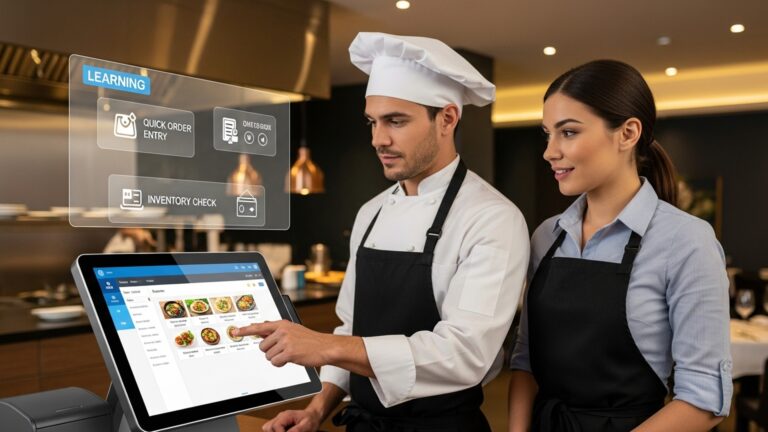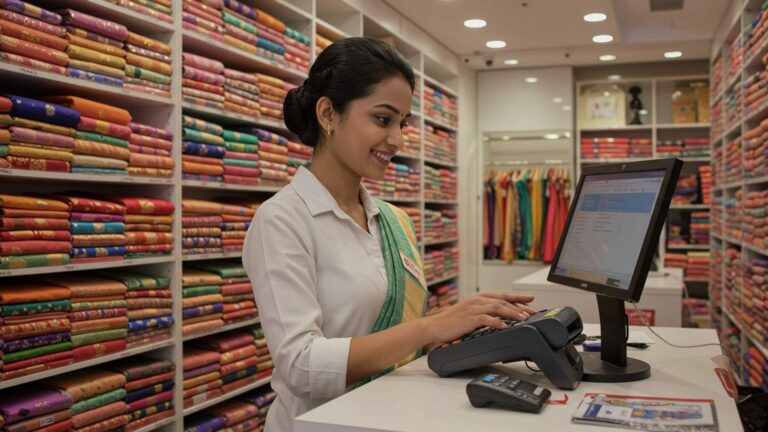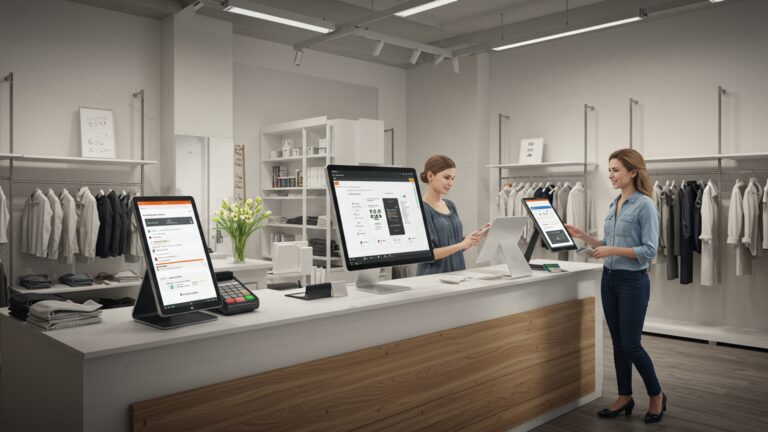Unlock Efficiency 6 Common Restaurant Problems Solved by POS Systems
In the high-stakes culinary world, operational inefficiencies can quickly erode profitability, turning daily service into a chaotic struggle. From misplaced orders and inconsistent inventory counts to agonizingly slow table turnovers and complex staff scheduling, restaurants constantly battle a myriad of challenges that directly impact customer satisfaction and bottom lines. Modern Restaurant POS software emerges as the pivotal technology addressing these pervasive pain points, transcending basic transaction processing to offer integrated solutions. It transforms the back-of-house chaos and front-of-house friction into streamlined workflows, leveraging real-time data analytics and automated processes to optimize every facet of the dining experience in today’s demanding market.
Solving Order Accuracy and Kitchen Communication Breakdowns
One of the most frustrating and costly challenges for any restaurant is the breakdown in order accuracy and kitchen communication. Handwritten tickets can be illegible, verbal instructions can be misunderstood. modifications often get lost in translation. This leads to incorrect dishes, wasted ingredients, longer wait times, unhappy customers. ultimately, a negative impact on your bottom line. Industry reports consistently highlight miscommunication as a leading cause of food waste and customer complaints in the hospitality sector.
Modern Restaurant POS software directly addresses this by digitizing the entire order process. When a server takes an order using a tablet or a fixed terminal, the data is instantly and accurately transmitted to the kitchen, typically displayed on a Kitchen Display System (KDS) or printed on a ticket printer. Every item, every modification (e. g. , “no onions,” “extra crispy,” “allergy alert”). every special request is clearly communicated without ambiguity.
Consider a bustling Friday night dinner service. Before implementing a robust POS system, a popular bistro in New York City struggled with a 10-15% error rate on complex orders, leading to multiple re-fires and apologies. After integrating a new Restaurant POS software, their error rate dropped to under 2%, significantly improving kitchen efficiency and customer satisfaction. The digital trail ensures accountability and clarity, transforming kitchen operations from chaotic to streamlined.
For a clear understanding of how an order might be digitally structured and communicated to the kitchen, consider this simplified data representation:
{ "orderId": "ORD-00123", "tableNumber": 7, "items": [ { "itemId": "SKU-001", "name": "Classic Burger", "quantity": 1, "modifications": ["No Onions", "Add Cheese"], "status": "New" }, { "itemId": "SKU-005", "name": "Fries", "quantity": 1, "modifications": [], "status": "New" } ], "timestamp": "2023-10-27T14:30:00Z", "status": "Pending"
}
To maximize order accuracy, ensure all staff are thoroughly trained on using the modification features within your Restaurant POS software. Regularly review KDS logs or printed tickets to identify any recurring communication issues and address them proactively through system configuration or additional staff training.
Streamlining Inefficient Inventory Management and Cost Control
Manual inventory management is a notorious time sink and a major source of financial leakage for restaurants. From stockouts of popular items to excessive waste due to spoilage, inaccurate food costing. even undetected theft, traditional methods are prone to human error and lack real-time visibility. Without precise control over ingredients, profitability takes a significant hit, making strategic menu planning almost impossible.
Modern Restaurant POS software integrates powerful inventory management modules that revolutionize how restaurants track and control their stock. These modules track ingredient usage in real-time as orders are placed, automatically deducting items from your inventory counts. This provides an always up-to-date picture of your stock levels, triggers automated reorder alerts when supplies run low. helps identify discrepancies through variance reports.
- Inventory Management Module
- Restaurant POS software
Consider a popular farm-to-table restaurant renowned for its fresh, seasonal ingredients. Previously, managers spent hours each week manually counting produce, leading to frequent over-ordering of perishable items and occasional stockouts of signature dishes. With their new Restaurant POS software, every ingredient used in a sold dish is automatically deducted. The system now alerts them when organic chicken breasts are running low, preventing disruptions. provides detailed reports showing exactly how much basil was used last week, enabling them to optimize purchasing and reduce waste by 20%.
Regularly reconcile your physical inventory counts with the data provided by your Restaurant POS software to catch discrepancies early. Leverage the system’s reporting features to review COGS for each menu item, allowing you to adjust pricing, portion sizes, or supplier choices to optimize profitability.
Accelerating Slow and Securing Insecure Payment Processing
In today’s fast-paced dining environment, slow payment processing is a major source of customer frustration, leading to long queues and reduced table turnover. Also, outdated payment systems often lack the necessary security features, exposing businesses and customers to risks of fraud and data breaches. Limited payment options also alienate customers who prefer mobile wallets or specific card types.
Contemporary Restaurant POS software addresses these issues head-on by integrating advanced payment processing capabilities. These systems allow for quick, secure transactions, supporting a wide array of payment methods including traditional credit/debit cards, EMV chip cards, contactless payments (like Apple Pay and Google Pay). even gift cards. They handle tip management efficiently, often allowing customers to add tips directly on the payment screen. automatically distribute them to staff.
- EMV compliant
- PCI DSS (Payment Card Industry Data Security Standard)
Let’s compare traditional payment methods with the capabilities of modern Restaurant POS software:
| Feature | Traditional Cash Register/Separate Terminal | Modern Restaurant POS Software |
|---|---|---|
| Payment Speed | Often slow, manual entry on separate terminal, potential for errors. | Fast, integrated, one-step process directly from order. |
| Payment Options | Limited to cash, basic magnetic stripe cards. | Cash, all major credit/debit cards, EMV chip, contactless (NFC), mobile payments, gift cards. |
| Security | Higher risk of manual errors, less encryption, vulnerable to skimming. | EMV chip readers, end-to-end encryption, PCI DSS compliance, tokenization. |
| Tip Management | Manual calculation and distribution, prone to errors and disputes. | Automated tip pooling/distribution features, easily adjustable. |
| Mobility | Fixed at a counter. | Can be mobile (tablets) for tableside ordering and payment. |
A popular cafe chain, “Brew & Bites,” struggled with customer queues during peak morning hours due to slow card readers. By implementing a Restaurant POS software with integrated, contactless payment options and mobile payment terminals for tableside service, they reduced average transaction time by 40%. This not only sped up service but also increased customer satisfaction and boosted tips for staff.
Invest in Restaurant POS software that offers robust, integrated payment processing with EMV and PCI DSS compliance. Offer a variety of payment options, including mobile and contactless payments, to cater to customer preferences and enhance checkout efficiency and security.
Optimizing Inefficient Staff Management and Scheduling
Managing restaurant staff can be a complex and time-consuming endeavor. Manual time tracking is susceptible to “buddy punching” and payroll errors, while creating fair and efficient schedules based on fluctuating demand is a constant headache. A lack of clear performance insights can lead to demotivated employees, high turnover rates, increased labor costs. overall operational inefficiencies, directly impacting service quality.
Many advanced Restaurant POS software solutions come equipped with integrated staff management features designed to streamline these processes. These often include digital time clocks where employees clock in and out, eliminating manual entry and reducing time theft. Scheduling modules allow managers to create optimal schedules based on forecasted demand, employee availability. labor cost targets, often with drag-and-drop interfaces.
Moreover, these systems provide detailed labor cost reporting, offering insights into wages as a percentage of sales, overtime hours. individual staff performance. This data empowers managers to make informed decisions about staffing levels and identify opportunities for efficiency improvements.
For example, a regional family dining chain, “The Supper Club,” was grappling with excessive overtime pay and inconsistent service quality due to poor scheduling. Their general manager spent nearly a full day each week manually building schedules. After adopting a Restaurant POS software with an integrated scheduling module, they could generate optimal schedules in minutes, factoring in sales forecasts and employee availability. This resulted in a 10% reduction in labor costs and a noticeable improvement in staff morale due to fairer scheduling practices.
Leverage the time clock and scheduling features of your Restaurant POS software to minimize payroll errors and optimize staffing. Regularly review labor cost reports to ensure your staffing levels align with sales volume, adjusting schedules to prevent overstaffing during slow periods and understaffing during peak hours, thereby maximizing labor efficiency.
Building Customer Relationships and Loyalty Programs
In the competitive restaurant industry, retaining customers is often more cost-effective than acquiring new ones. But, many restaurants struggle to identify and reward their most loyal patrons, offer personalized experiences, or implement effective loyalty programs due to a lack of centralized customer data. This hinders repeat business and limits the effectiveness of marketing efforts.
Modern Restaurant POS software is increasingly incorporating robust customer relationship management (CRM) functionalities. These systems can store valuable customer data, including contact details, order history, dietary preferences. even special occasions like birthdays. This data forms the foundation for effective loyalty programs, allowing restaurants to track visits, reward frequent diners. send targeted promotions.
A leading expert in hospitality technology, Jane Doe, founder of “DineTech Solutions,” states, “The ability of a POS system to capture and utilize customer data is no longer a luxury. a necessity. It transforms transactional interactions into lasting relationships, driving repeat business and brand advocacy.”
Consider “The Daily Grind,” a local coffee shop that used to rely solely on paper punch cards for loyalty. Their new Restaurant POS software allowed customers to sign up for a digital loyalty program, tracking their favorite drink orders and visit frequency. The system now automatically sends a personalized offer for a free latte after every 10 purchases and a birthday discount on their actual birthday. This initiative led to a 15% increase in repeat customer visits and a more engaged customer base.
Actively encourage customers to sign up for your loyalty program through your Restaurant POS software. Utilize the collected data to personalize marketing messages, tailor special offers. create a more bespoke dining experience for your most valued patrons, fostering deeper engagement and loyalty.
Empowering Business Decisions with Sales Reporting and Analytics
Without accurate and timely data, making informed business decisions in the restaurant industry is akin to flying blind. Relying on manual sales summaries or outdated reports makes it challenging to identify best-selling items, interpret peak hours, track staff performance, or pinpoint areas of inefficiency. This can lead to missed opportunities, suboptimal menu engineering. reduced profitability.
Advanced Restaurant POS software excels in collecting vast amounts of sales data and transforming it into actionable insights through comprehensive reporting and analytics dashboards. These systems track every transaction – what was sold, when it was sold, by whom. how it was paid for. This data is then presented in easy-to-grasp reports on menu item popularity, busiest times of day or week, server efficiency, average check size. overall profitability.
For instance, a struggling tapas bar in San Francisco couldn’t interpret why their profit margins were consistently low despite seemingly busy nights. Their new Restaurant POS software provided detailed menu item reports, revealing that a high-cost signature dish, while popular, was barely breaking even due to ingredient waste and preparation time. By adjusting the recipe and price based on this data. promoting other higher-margin items, they increased their profit margins by 7% within three months without sacrificing customer satisfaction.
The reporting capabilities extend beyond just sales. You can generate reports on inventory variance, labor costs as a percentage of sales, customer loyalty program performance. even void/comp rates, providing a holistic view of your restaurant’s operations.
Make it a habit to regularly review the comprehensive sales and operational reports generated by your Restaurant POS software. Focus on identifying trends in menu item performance, peak sales periods. staff productivity. Use these data-driven insights to optimize your menu, refine staffing schedules, fine-tune marketing strategies. make confident, profitable business decisions.
Conclusion
Having explored how modern POS systems skillfully tackle six common restaurant challenges, it’s evident that this technology is far more than just a transaction tool; it’s your strategic partner in operational excellence. In my view, the true power isn’t in merely owning a POS. in diligently leveraging its rich data. For instance, use its real-time analytics to pinpoint peak service times for optimal staffing, or identify which menu items are genuinely underperforming, allowing for swift adjustments rather than guesswork. Recent developments, like AI-driven inventory forecasting and seamless third-party delivery integrations, mean your POS can now predict stock needs and manage diverse order streams, streamlining processes further. Don’t let your investment collect dust; actively train your team and explore its full capabilities. This commitment transforms potential problems into pathways for growth. Embrace this technological shift. you’ll not only enhance customer satisfaction but also build a more resilient, profitable. stress-free operation. Your restaurant’s future efficiency truly begins with an intelligently utilized POS. To maximize your investment, I highly recommend exploring Master 8 Key Strategies for Optimizing Your Restaurant POS Usage.
More Articles
Discover 10 Smart Ways Restaurant POS Software Boosts Profits
7 Essential POS Features Restaurant Owners Must Learn to Master
How to Choose The Best Restaurant POS System A 5 Step Guide
Learn 8 Common Mistakes to Avoid When Using Restaurant POS
FAQs
My kitchen often gets wrong orders, leading to wasted food and unhappy customers. How can a POS help?
A good POS system streamlines the ordering process by sending orders directly from the server’s handheld device or terminal straight to the kitchen display system (KDS) or printer. This eliminates handwriting errors and miscommunication, ensuring the kitchen always sees exactly what the customer ordered, every time.
We’re constantly getting complaints about slow service and long wait times. Does a POS make things faster?
Absolutely! POS systems speed up nearly every aspect of service. Servers can take orders quickly at the table, payments are processed faster with integrated options. kitchen staff get orders instantly. This all contributes to quicker table turns and a much smoother dining experience for your guests.
Keeping track of our ingredients feels like a constant battle. we end up with a lot of waste. Can a POS really help with inventory?
Yes, many modern POS systems come with robust inventory management features. They track ingredients as they’re used in dishes, alert you when stock is low. help identify popular items versus those that sit too long. This helps reduce spoilage, control costs. ensures you always have what you need on hand.
I worry about cash disappearing or unauthorized discounts happening. How does a POS system combat internal theft?
A POS system creates a clear audit trail for every transaction. It tracks who logged in, what was sold, discounts applied. voids. This transparency makes it much harder for employees to commit theft or give away food without proper authorization, significantly improving accountability across the board.
It’s hard to tell what’s selling well or when our busiest times are. Can a POS give me better insights?
Definitely. POS systems are fantastic for generating detailed sales reports. You can easily see which dishes are most popular, track sales by hour, day, or server. even identify peak performance times. This data is invaluable for making smart business decisions, like menu adjustments or staff scheduling.
Dealing with different payment types and splitting bills is often a hassle. Does a POS simplify payments?
A major benefit of a POS system is its integrated payment processing. It handles credit cards, debit cards, mobile payments. even gift cards seamlessly. Splitting bills among multiple guests becomes a breeze, directly from the system, saving time and preventing calculation errors for both staff and customers.






